Search results for: 'Ancient bronze'
-
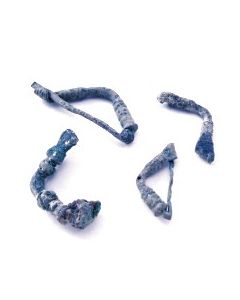 Gruppe von 4 Bronzefibeln
Gruppe von 4 Bronzefibeln800 v.Chr. bis 300 n.Chr. , Eisenzeit. Diverse Typen einschließlich hellenistischer und römischer Fibeln. Nadeln fehlend oder restauriert.
Price: on request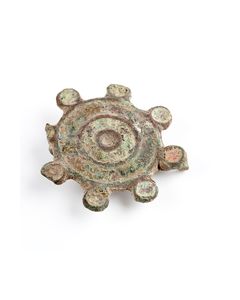 Römische Scheibenfibel mit Einlagen aus Emaille
Römische Scheibenfibel mit Einlagen aus EmailleSpätes 1. Jh. n. Chr. bis 2. Jh. n. Chr. Fund aus der Region Region der Limeskastelle Pförring, Eining, Pfünz, Kösching und Weißenburg.
Price: on request Very rare double-spouted Roman bronze oil lamp
Very rare double-spouted Roman bronze oil lampImpressive, massive piece with great patina. With original chains and hook
Price: on request Keltisch-römische Ringfibel
Keltisch-römische Ringfibel1. Jh. v.Chr. bis 1. Jh. n.Chr., Ende der keltischen Epoche, Beginn der römischen. Hervorragender Zustand, schön patiniert, mit Nadel. Rautenförmiger Querschnitt.
Price: on request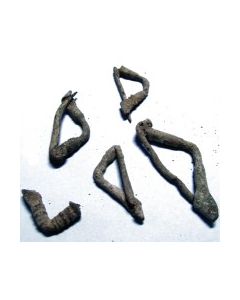 Gruppe von 5 Bronzefibeln
Gruppe von 5 Bronzefibeln800 v.Chr. bis 300 n.Chr. , Eisenzeit. Diverse Typen einschließlich hellenistischer und römischer Fibeln. Nadeln fehlend oder restauriert. Eine Fibel als Fragment erhalten, anderen intakt.
Price: on request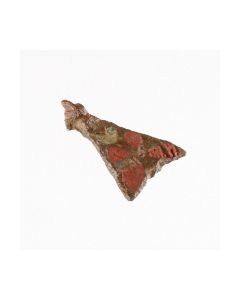 Roman cicada brooch
Roman cicada broochBrooch in the shape of an insect. Popular type in the northern Roman provinces during the 2nd century.
Price: on request Gruppe von 3 Bronzefibeln
Gruppe von 3 Bronzefibeln800 v.Chr. bis 300 n.Chr. , Eisenzeit. Diverse Typen einschließlich hellenistischer und römischer Fibeln. Nadeln fehlend oder restauriert.
Price: on request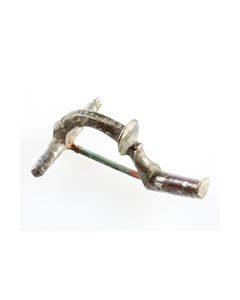 Römische Armbrustfibel aus Silber und Bronze
Römische Armbrustfibel aus Silber und BronzeP-förmiger Fibelkörper mit Zierelementen. Vorform der Zwiebelkopffibel aus dem 3. Jh. n. Chr.
Price: on request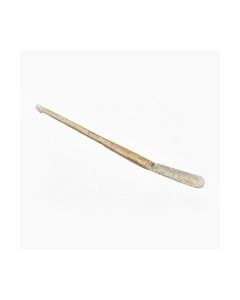 Roman strigilis with workshop mark
Roman strigilis with workshop markExcellently preserved, massive bronze, stable. Workshop mark "N" on the reverse.
Price: on request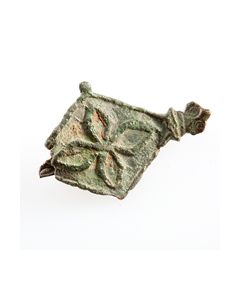 Rautenförmige Brosche mit Resten von Email
Rautenförmige Brosche mit Resten von EmailRömische Brosche aus dem 2. Jh. n. Chr. Rautenförmige Platte mit Blütenmuster, einst mit roter Email ausgestaltet.
Price: on request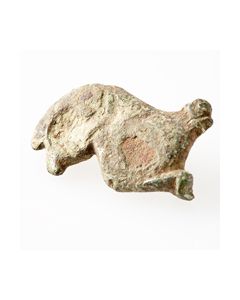 Römische zoomorphe Fibel
Römische zoomorphe FibelAntike Fibel in Form eines stilisierten Kaninchens. Massive Bronze. Beliebte aber seltene Variante. 1. Jh. n. Chr. bis 2. Jh. n. Chr.
Price: on request Roman silver fibula
Roman silver fibulaInteresting type of brooch from the Roman Imperial period. Nice specimen made of silver.
Price: on request Roman fibula in the shape of a rabbit
Roman fibula in the shape of a rabbitNice zoomorphic roman fibula made of bronze with enamel inlays depicting the young of the rabbit. Found near the Limes fortifications Pfoerring and Eining in Germany.
Price: on request Roman Hod Hill brooch
Roman Hod Hill broochMade around the year 100 and found on the Isle of Wight, after the Roman conquest of Britain.
Price: on request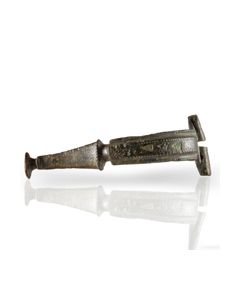 Roman Hod Hill brooch from the Hattatt collection
Roman Hod Hill brooch from the Hattatt collectionNice and rare enameled variant of the Hod Hill type. Found in Norfolk, UK. The piece is published in two books by Richard Hattatt.
Price: on request Disc brooch from Roman Britain
Disc brooch from Roman BritainNicely enameled brooch with a Romano-Celtic sunburst design. From the 2nd century AD. Published in two stardard works on ancient brooches by Richard Hattatt.
Price: on request Gruppe antiker Gewichte aus dem heiligen Land
Gruppe antiker Gewichte aus dem heiligen LandInsgesamt 21 Exemplare. Hervorragender Zustand. Durchmesser 6 mm - 17 mm. Einzelgewicht von 0.29 g bis 9.02 g. Zusammen 67.65 Gramm.
Price: on request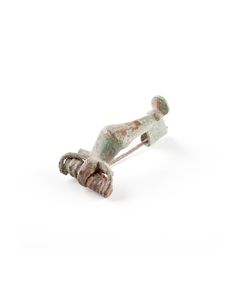 Römische Kniefibel
Römische KniefibelKaiserzeitliche Fibel vom Typ der Kniefibeln. Variante mit ungedeckter Spiralhalterung der Feder. 2. Jh. n. Chr. 44mm lang.
Price: on request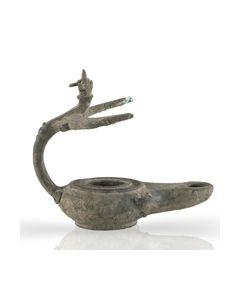 Roman bronze oil lamp - ex Christie's
Roman bronze oil lamp - ex Christie'sFrom an old Swiss private collection, acquired before 1971. Between 1971 and 2022 on loan and exhibition at the Antikenmuseum Basel.
€1,280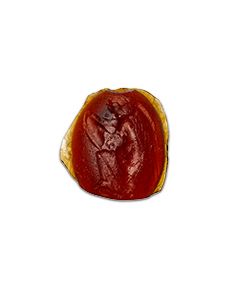 Roman intaglio with goddess of victory
Roman intaglio with goddess of victoryThe glass paste features a famous depiction of Victoria writing the names of victors in battle on a large shield. The motif reiterates a 1st century bronze statue.
Price: on request Roman intaglio with goddess of victory
Roman intaglio with goddess of victoryThe glass paste features Victoria writing the names of victors in battle on a large shield.
Price: on request Rare frog fibula
Rare frog fibulaZoomorphic fibula dating to the Roman Principate. Very nice enameled work. Rare variant of this popular fibula type from Roman Gaul.
Price: on request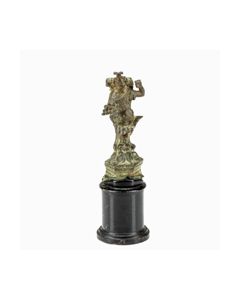 Roman bronze tripod foot with Dionysos
Roman bronze tripod foot with DionysosExtremely well preserved, detailed piece of ancient art wth beautiful patina. Ex Bonhams, before that in the collection Joseph Klein, New York, USA.
Price: on request Roman plate brooch
Roman plate broochBeautiful example with orange and turquoise enamel. A find from 2nd century Roman Britain.
Price: on request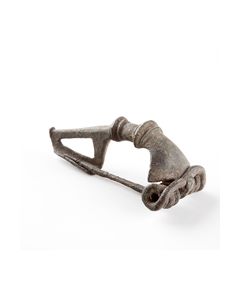 Römische Kräftig Profilierte Fibel
Römische Kräftig Profilierte FibelFibeltyp der frühen römischen Kaiserzeit, sogenannte kräftig-profilierte Fibel. 1. Jh. n. Chr., 58mm lang, in museumswürdiger Erhaltung.
Price: on request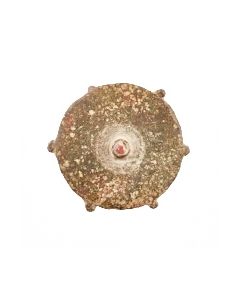 Roman plate brooch found at the Limes
Roman plate brooch found at the LimesAncient brooch with circular plate. Found near the Limes fortifications Pfoerring and Eining in Germany.
Price: on request Roman strigilis
Roman strigilisBeautifully decorated with tendrils and a dolphin
Price: on request Römische Scheibenfibel mit Glaskamee
Römische Scheibenfibel mit GlaskameeAntike Brosche mit Glasverzierung in Gesichtsform. Sehr seltenes Schmuckstück, Kamee von hervorragender Qualität. 2. bis 5. Jh. n. Chr. 32mm Durchmesser, 7,3g.
Price: on request Enameled disc brooch from Britain
Enameled disc brooch from BritainColourful enameled brooch from the Roman Imperial period. Published in two stardard works on ancient brooches by Richard Hattatt.
Price: on request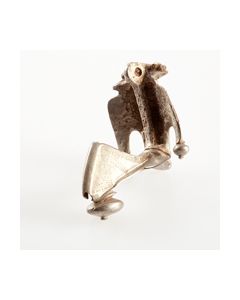 Kräftig profilierte Silberfibel, 2. bis 3. Jh. n. Chr.
Kräftig profilierte Silberfibel, 2. bis 3. Jh. n. Chr.Römische Fibel vom Typ der kräftig profilierten Fibeln. Massives Silber, 34,2g, 100 bis 250 n. Chr. Museumswürdiger Zustand.
Price: on request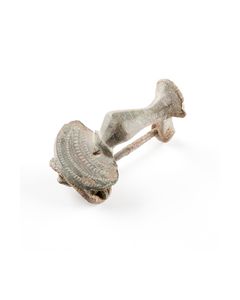 Römische Kniefibel
Römische KniefibelKaiserzeitliche Fibel vom Typ der Kniefibeln mit halbrunder Kopfplatte. 2. bis Mitte 3. Jh. n. Chr. 37mm lang.
Price: on request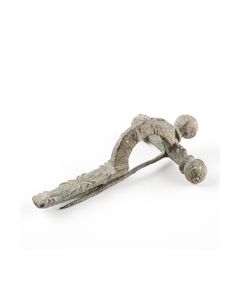 Römische Armbrustfibel
Römische ArmbrustfibelProminente kugelförmige Knöpfe. Direkter Vorläufer der Zwiebelknopffibeln. Soldatenfibel aus der 1. Hälfte des 4. Jh. n. Chr. 76mm lang.
Price: on request Brooch from Roman Britain
Brooch from Roman BritainA rare mixture of cicada fibula and trumpet fibula, from the 2nd century. Found on the Isle of Wight.
Price: on request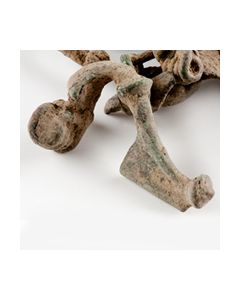 10 römische Fibeln aus Pannonien
10 römische Fibeln aus PannonienDiverse Typen, meist Kniefibel oder ähnliche. Bronze, gute Erhaltung, Nadeln fehlen. Ca. 3. - 4. Jh. n. Chr.
Price: on request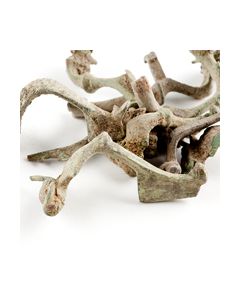 10 römische Fibeln aus Pannonien
10 römische Fibeln aus PannonienDiverse Typen, meist Kniefibel oder ähnliche. Bronze, gute Erhaltung, Nadeln fehlen. Ca. 3. - 4. Jh. n. Chr.
Price: on request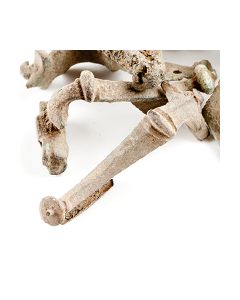 10 römische Fibeln aus Pannonien
10 römische Fibeln aus PannonienDiverse Typen, meist Kniefibel oder ähnliche. Bronze, gute Erhaltung, Nadeln fehlen. Ca. 3. - 4. Jh. n. Chr.
Price: on request

